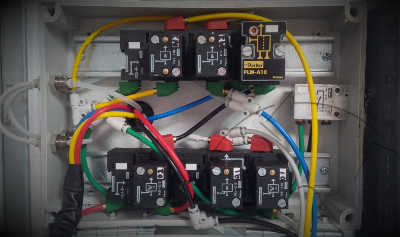
The world’s first air-powered PL(d)/Cat3 bin tipping machine
There are not many options when you need a 250kg capacity bin-tipping machine that can operate in an explosive environment. And have variable speed. Oh, and have a locking door and safety system compliant with Performance Level ‘d’. In fact, there’s only one.
Sorry, Performance Level ‘d’?
Performance Level ‘d’ (also known as Cat3) is the second-highest ISO13849 safety rating, and is the most common level for applications with very strict H&S requirements. It is almost like a guarantee that the machine will never be ‘unsafe’ at any time throughout its entire design life, even if individual components wear out or fail.
To achieve this, the ‘Safety Concept’ must be carefully analysed, and every possible scenario investigated. If the operator could be exposed to harm following the failure of a single part, there must be two of them. And if any part does fail, the system must warn the operator and shut down before anyone can be exposed to a hazard.
Performance Level (d) means every ‘safety-critical’ part must be monitored to ensure it is working correctly.

The engineers must identify whether there may be any incentive for an operator to bypass (or attempt to) any safety function. If there is, it needs to be provided for and guarded against.
Additionally, the situation the machine will be used in also forms part of the ‘Safety Concept’. A machine may be perfectly safe and meet all standards in one application, and fail miserably in a different application. The process of making a ‘safe machine’ involves taking many things into consideration such as the number of cycles per day, the number of operators, the skill level and training of operators, public access, and many other things.
Achieving Performance Level (d) is a fairly daunting task on an electrically-powered machine but is now reasonably common, with a large range of high-technology electronic monitoring equipment available. Achieving the same safety level using compressed-air equipment only (due to fire or explosion hazards) is much more challenging. In fact, it was often thought to be impossible due to the perceived unpredictability and unreliability of pneumatic equipment.
However, in 2016 the engineers at Simpro Handling Equipment designed, built and commissioned an air-powered 250kg capacity bin-tipping machine which achieved Performance Level (d). Here’s how we did it.
Achieving PL(d) with no electronics
First, we started with the proven design of the Simpro Dumpmaster bin tipper. The Safety Concept for the Dumpmaster is based on the following well-established conditions:
- The machine is fully guarded and all hazards are confined within the guarded area.
- The cradle cannot be raised above ground level unless the door is closed and locked.
- The door cannot be unlocked or opened unless the cradle is at ground level
The challenge was to devise a safety system that effectively gives an unconditional guarantee that these conditions are met, every single time throughout an expected machine lifetime of half a million cycles.
Every valve and component that could affect the safety of the machine had to be analysed, to determine what would happen if an input tube came off, an output tube came off, the valve itself moved or fell off, or the valve stuck on or stuck off. Even the monitoring valves were themselves monitored to make sure the machine remained safe if one of them failed to do its task.
Every system was powered by air alone, with no electricity or electronics or any kind.
The completed control system eventually used more than 25 individual air valves, only a few of which were actively used during a normal cycle. Most were used for logic processing, backups, or monitoring other valves, ready to shut the machine down if any fault or discrepancy was detected.

Conclusion
Building truly safe machinery – powered by air or electricity – is a challenging task. It involves a huge amount of research and development, and a deep knowledge of the way humans interact with the equipment they use. In fact, every day there are headlines about serious harm caused by supposedly-safe machines whose designers neglected to consider the full matrix of environmental and human factors involved in workplace safety.
So we are very proud of the Simpro engineers who made a powerful industrial machine designed to cause cause Zero Harm to its operators – using not a single microchip, actuator or electric circuit.